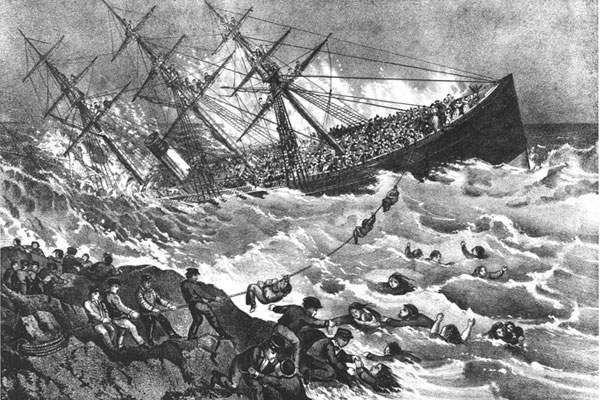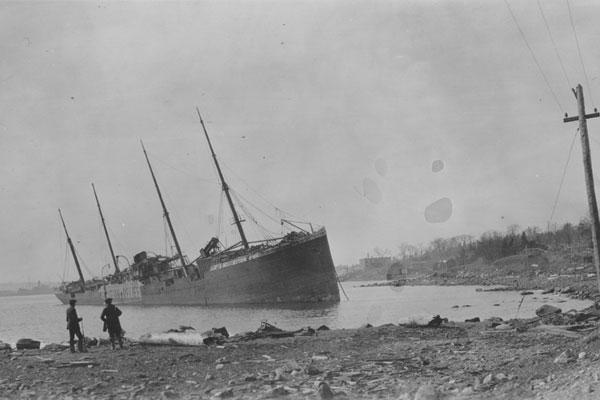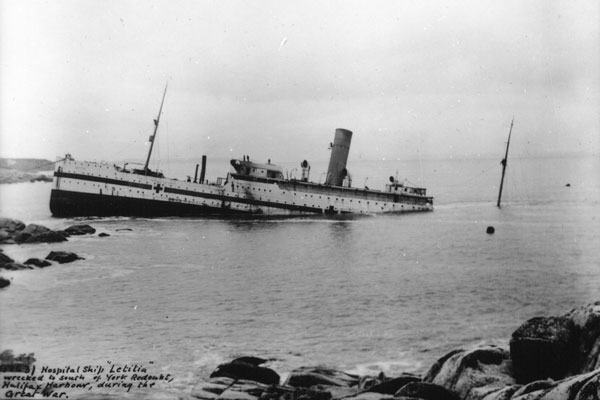Being surrounded by this much ocean means that Halifax and Nova Scotia have a long history of shipwrecks. In fact, there are so many shipwrecks around here that we have a museum with an entire database of them! The Maritime Museum of the Atlantic in Halifax - which you should totally visit because there’s lots of cool stuff there - has an online database of 5,000 shipwrecks, with 250 photos of shipwrecks to explore. But since you probably don’t have time to read about thousands of sunken boats, we’ve made a list of a few of the most interesting stories of historic shipwrecks around the Halifax region.
The SS Atlantic
Some say that the sinking of the SS Atlantic isn’t as famous as it should be. It was the worst single-vessel shipwreck of all time to happen in Canadian waters until the sinking of the Titanic in 1912. The SS Atlantic was one of the nicest passenger vessels of its time, a transatlantic ocean liner, like the Titanic, that used both sail and steam for power.
In the wee hours of the morning on April 1, 1873, during the ship’s 19th voyage, the SS Atlantic hit rocks at Marrs Head near Lower Prospect on its way into the Halifax Harbour. While some 562 passengers and crew were sadly lost in this disaster, thanks to the efforts of fishermen from Lower Prospect, Upper Prospect and Terence Bay, more than 400 passengers were saved. You can learn more about this historic shipwreck right near the place where it happened, at the SS Atlantic Interpretation Centre and Heritage Park in Terence Bay, on the road out to Peggy’s Cove.
WRECKED: 1873
LOCATION: Marrs Head, near Terence Bay
CAUSE OF WRECK: Broke on the rocks
CARGO: China dishes, mail, mixed goods
VESSEL TYPE: Barque, steam
LENGTH: 128 m / 420 ft
WEIGHT: 3,390 tons / 6,780,000 lbs
LEARN MORE
SS Atlantic Interpretation Centre
178 Sandy Cove Rd, Terence Bay
The Interpretation Centre is open from the last weekend in May to the end of October. The Heritage Park is open year-round.

This engraving shows the desperate struggle to escape the wreck of the SS Atlantic and the heroic struggle of rescuers in the biggest ocean liner disaster before the Titanic sinking.
Photo credit: Maritime Museum of the Atlantic, MP18.126.5a
The Mysterious Copper-Clad Schooner
There’s a shipwreck right at the bottom of the Halifax Harbour that has baffled researchers for years. When it was discovered in 2002, no one could say where the ship came from, or even its name!
The ship is a schooner covered in copper and brass, which means it would have been very expensive to build, but there are absolutely no records of it sinking. Because this vessel is so valuable, researchers wondered if it may have been owned by a rich family, or perhaps by the British Royal Navy.
Some think the ship may have sunk during the Halifax Explosion, a huge explosion that flattened most of the city in 1917 after two ships collided in the Harbour. When researchers went back and examined the clues again in 2017, they narrowed it down to two ships it might have been; the St. Bernard and the Lola R, both lost in the Halifax Explosion. Still, no one could agree that there was enough evidence to say for sure and it has remained a mystery ever since.
WRECKED: 1917 ?
LOCATION: Halifax Harbour, near the Halifax Shipyard
CAUSE OF WRECK: Halifax Explosion ?
VESSEL TYPE: Schooner
What is a schooner? A schooner is a type of sailing ship with at least two masts and sails, ideal for sailing on windy coastal waters.
The Salerno
In the Litchfield Shoals off Herring Cove here in Halifax, the British steamer Salerno was wrecked on July 1, 1905. The ship was carrying salt from Cadiz, Spain, on its way to Halifax. What makes this shipwreck so interesting is that it’s one of a few around Nova Scotia that you can still explore!
Anyone with a scuba diving certificate can book a guided tour to see the Salerno where she still lies on the ocean floor. Pretty cool!
WRECKED: 1905
LOCATION: Litchfield Shoals, near Herring Cove
CAUSE OF WRECK: Fog
CARGO: Salt
VESSEL TYPE: Schooner, steam
LENGTH: 92 m / 301 ft
WEIGHT: 1,683 tons / 3,366,000 lbs
LEARN MORE
Note: The minimum age for kids to learn to scuba dive in Nova Scotia is 10 years old.
The Graveyard of the Atlantic
Sable Island is a tiny sandbar island located 300km off the coast of Nova Scotia. The island has earned the nickname, Graveyard of the Atlantic from the many ships that have sunk or been abandoned there over the years. They say that this is because the island is “hidden by waves, storms and fog”. Since 1583 there have been more than 350 recorded shipwrecks on Sable Island, but today there isn’t much left to show for it, as most of the wreckage has since been washed away.
On a more positive note, Sable Island is now known for its beautiful wild horses and enormous colony of grey seals.
LEARN MORE ABOUT THE GRAVEYARD OF THE ATLANTIC

This photograph was taken on Sable Island during a visit by Alexander Graham Bell a few days after Crofton Hall went aground. Her hull is held captive by the sand while the waves pound it apart. A few days later the hull broke apart and within weeks nothing was visible.
Photo credit: Maritime Museum of the Atlantic, MP2.211.2, (MP2.221.2a), N-16,416
Visit the Maritime Museum of the Atlantic to learn more about Nova Scotia's rich seafaring history.

Imo, wrecked 1917, The Narrows, Halifax Harbour. This photograph shows the steamship Imo aground after the Halifax Explosion. Imo's collision with the munitions ship Mont Blanc triggered the explosion that devastated the harbour and North End of Halifax.

Letitia, wrecked 1917, Portuguese Cove. This photograph shows every captain's nightmare - a sinking hospital ship full of wounded soldiers. Miraculously, the 546 soldiers were all rescued, although one sleeping crew member was left behind and later drowned.

Steamship Skidby, wrecked 1905, Sable Island. This photograph shows the steamship Skidby held captive by the sands of Sable Island. Within a few months her hull was ripped apart by the waves leaving only her boilers visible.

Martin van Buren, wrecked 1945, Duck Reef near Sandy Cove. This photograph shows an American liberty ship sunk by the German submarine U-1232 while approaching Halifax. She drifted ashore at Sandy Cove near Sambro Harbour where her wartime cargo became a bonanza for salvagers whose boats can be seen around her.
Photo credit: Maritime Museum of the Atlantic


